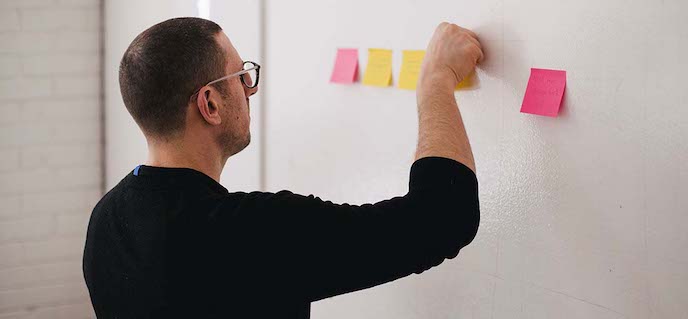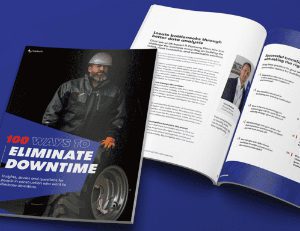

Some of the world’s leading brands like Apple, Coca-Cola, Google, and GE have adopted the Design Thinking approach. Design Thinking is also being taught at leading universities such as Stanford, Harvard and MIT. But why is it gaining so much popularity? What is it that Design Thinking does in order to attract the interest of the business world? And how can we learn from it and use it in the construction industry?

Design Thinking is not the exclusive property of creative designers. The approach, however, does make use of the designer’s work processes in helping solve complex business challenges in a creative and human-centered way.
In this blog post I will walk you through why getting your hands dirty with Design Thinking helps you develop game-changing innovative solutions for your business.
We like to devise and create a product with all the required features perfectly engineered – and then finish with a glorious product launch. Just think of a new equipment launch of any OEM – we all recognize this pattern, right? This is the approach we’re used to and feel comfortable executing.
However, such a feature-first approach only lets us exploit what we know beforehand and what we have already defined. Design Thinking on the other hand helps you adopt a human-centered mindset and shift your focus to the end-user. It allows you to dig deep into the thinking and feeling of others and thereby get a real understanding of your user’s needs.
The end-user and his needs are the focal point and the driver for the entire approach – not just an afterthought.
So instead of thinking feature-first, the goal in Design Thinking is to always get under the skin of the end-user to understand his pains and frustrations and then work your way to a solution that helps relieve these pains. Applying this approach to the construction industry, we will be provided with new perspectives on how to solve the real daily struggles of the machine operators, technicians and fleet managers out there. And then based on this insight, we either develop or adjust a product into fitting the needs of the real-life users.

It may sound easy, but in reality, it is hard to take that step back and release yourself of the presumption that you already understand what kind of product your end-user wants. Because you don’t. There is even a fair chance that the end-user doesn’t either.
To do this you need empathy. Design Thinking gives you the toolkit for empathy, so you can feel what it is like walking in your end-user’s shoes. By observing the end-user in his environment, you can tap into the feelings and frustrations that need problem-solving. It is not until we get as frustrated as our end-users and understand their experiences and preferences that we are able to design a product for them. Such a product will not only be well engineered, but also well designed.
Most of today’s business problems and challenges can hardly be solved by any one discipline or single skill set. This is where multidisciplinary expertise provides interesting opportunities to solving the problems. As such, Design Thinking is not limited to a specific functional area or expertise. It encourages multidisciplinary teams and hybrid thinking to come together and leverage the power of collective expertise.
Most of today’s business problems and challenges can hardly be solved by any one discipline or single skill set. This is where multidisciplinary expertise provides interesting opportunities to solving the problems. As such, Design Thinking is not limited to a specific functional area or expertise. It encourages multidisciplinary teams and hybrid thinking to come together and leverage the power of collective expertise.

It is no news that when different people with different fields of expertise and know-how work together, they all bring something different to the table. This is the same principle as the construction companies starting to exploit the knowledge of tech companies in order to keep up with the changes in the industry.
When a group of experts are working together – with empathy for the users and systems out there – it is not expected, nor even desired, to come up with a perfect solution in the first go. In order to ensure that the product actually lives up to the promise of relieving the end-user’s pain, the ideas must be tested over and over again. With continuous feedback from end-users and customers you iterate until you get it just right. This is the power of Design Thinking.

There should be no fear of failing. If you want to make sure that the end-solution is right on target, it is necessary to fail fast and often. It only helps getting to the next stage of a good idea. So being wrong is not necessarily wrong. By constantly experimenting and not only executing you make sure to catch any errors or inconveniences before spending too much time and effort – and thereby money – on the wrong idea.
We must keep in mind that Design Thinking is all about “out of the box thinking”. It provides us with new methods and new ways of thinking about effective problem solving. The challenges that the construction industry is facing today is much more complex than what was the case ten or twenty years ago. So, in order to solve such problems, it is key to adapt new methods to help solve them efficiently.
An innovative solution is all about new and unexpected, so in all honesty, it is a little naïve to think that you can create the next innovative solution by employing the old and well-known procedures.
Design Thinking introduces a collaborative and non-linear human-centered approach and requires you to adopt a new mindset. In return Design Thinking will not only make sure that your solution is viable as it solves your end-user’s pain, but it will also help you create solutions that will leave your competitors behind in the innovation race.

Never miss an insight. We’ll email you when new articles are published on this topic.


